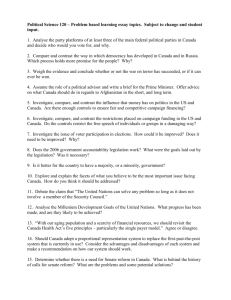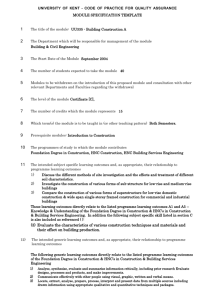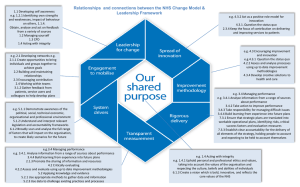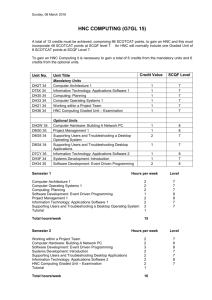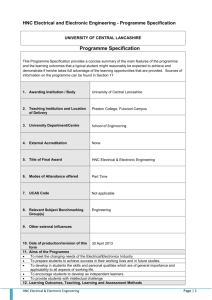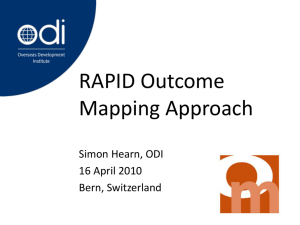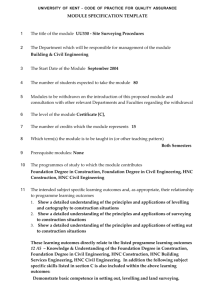University of Kent at Canterbury
advertisement
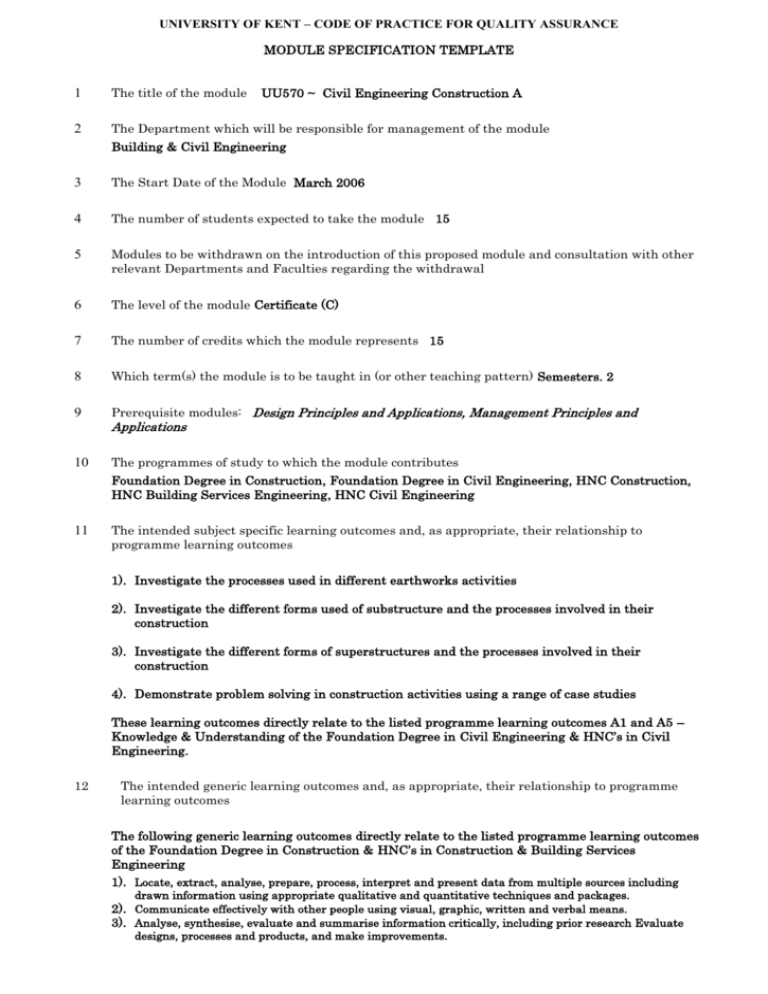
UNIVERSITY OF KENT – CODE OF PRACTICE FOR QUALITY ASSURANCE MODULE SPECIFICATION TEMPLATE 1 The title of the module UU570 ~ Civil Engineering Construction A 2 The Department which will be responsible for management of the module Building & Civil Engineering 3 The Start Date of the Module March 2006 4 The number of students expected to take the module 15 5 Modules to be withdrawn on the introduction of this proposed module and consultation with other relevant Departments and Faculties regarding the withdrawal 6 The level of the module Certificate (C) 7 The number of credits which the module represents 15 8 Which term(s) the module is to be taught in (or other teaching pattern) Semesters. 2 9 Prerequisite modules: Design Principles and Applications, Management Principles and 10 The programmes of study to which the module contributes Applications Foundation Degree in Construction, Foundation Degree in Civil Engineering, HNC Construction, HNC Building Services Engineering, HNC Civil Engineering 11 The intended subject specific learning outcomes and, as appropriate, their relationship to programme learning outcomes 1). Investigate the processes used in different earthworks activities 2). Investigate the different forms used of substructure and the processes involved in their construction 3). Investigate the different forms of superstructures and the processes involved in their construction 4). Demonstrate problem solving in construction activities using a range of case studies These learning outcomes directly relate to the listed programme learning outcomes A1 and A5 – Knowledge & Understanding of the Foundation Degree in Civil Engineering & HNC’s in Civil Engineering. 12 The intended generic learning outcomes and, as appropriate, their relationship to programme learning outcomes The following generic learning outcomes directly relate to the listed programme learning outcomes of the Foundation Degree in Construction & HNC’s in Construction & Building Services Engineering 1). Locate, extract, analyse, prepare, process, interpret and present data from multiple sources including drawn information using appropriate qualitative and quantitative techniques and packages. 2). Communicate effectively with other people using visual, graphic, written and verbal means. 3). Analyse, synthesise, evaluate and summarise information critically, including prior research Evaluate designs, processes and products, and make improvements. UNIVERSITY OF KENT – CODE OF PRACTICE FOR QUALITY ASSURANCE 13. A synopsis of the curriculum Earthworks: types, cuttings and embankments, slope stability, excavations: equipment, effectiveness, economical, efficiency; safety, consideration, regulations, precautions, trenches; temporary works, types, supports, timbering, de-watering Substructure: plant and equipment, piling systems, ground stabilisation, foundation; drainage, culverts services Superstructure: plant and equipment; structures, bridges, wide span; high rise buildings, concrete, steel; falsework/formwork, in-site, pre-cast; concrete, production, placement Case Studies: methods and resources, appropriateness; key considerations, inter-relationship of safety, environmental, quality, technical and economic factors; solutions, selection, planning and management of case study projects with regard to key considerations. 14. Indicative Reading List - Harris, F – Modern Construction and Ground Engineering Equipment and Methods 2 nd Edition – (Longman, 1994) Holmes, R – Introduction to Civil Engineering Construction 3 rd Edition (College of Estate Management, 1995) Tomlinson, M – Foundation Design and Construction 6th Edition – (Addison-Wesley, 1995) Warren, D – Civil Engineering Construction – (Palgrave Macmillan, 1996) Other publications - Journals such as New Civil Engineer, Construction News and Contract Journal In addition, the ICE (Institution of Civil Engineers) Works Construction Guides are useful, if brief, summaries of various topics which they cover 15. Learning and Teaching Methods, including the nature and number of contact hours and the total study hours which will be expected of students, and how these relate to achievement of the intended learning outcomes Students will be expected to spend a total of 150 hours of study, which will be apportioned as follows: 47 contact hours - involving a mixture of lectures, classes & tutorials. Much of the content will be directly taught incorporating a variety of class-based activities. Case studies will be used extensively in order to develop a working knowledge and practice of the construction industry. The production of sketches and drawings [manually or using CAD] to enhance the knowledge gained will be included. Learners will work both in groups and individually and may be required to provide oral presentations from their own studies or experiences. 40 hours – assessment & revision 63 hours – private study 16. Assessment methods and how these relate to testing achievement of the intended learning outcomes Assessment Evidence for learning outcomes is achieved through course work assignments (50%) and end of module examination (50%). Assessment will focus upon the individual achievement of each learner, however group work activities will also be part of the assessment strategy. Consideration will be given to health, safety and welfare throughout the delivery of this module. UNIVERSITY OF KENT – CODE OF PRACTICE FOR QUALITY ASSURANCE Subject Specific Learning Outcomes 1). Investigate the processes used in different earthworks activities 2). Investigate the different forms used of substructure and the processes involved in their construction Assessment Criteria Describe types of earthwork activities Evaluate the use of different types of earthmoving equipment for different situations Explain appropriate methods and resources to ensure safe and productive operations in earthworks Describe types of temporary works and dewatering Compare the use of different plant and equipment for substructure and drainage activities Compare different piling systems and ground stabilisation techniques Describe the construction of different foundations Describe the processes of drainage for different situations 3). Investigate the different forms of superstructures and the processes involved in their construction Compare the use of different plant and 4). Demonstrate problem solving in construction activities using a range of case studies Analyse the appropriateness of methods and equipment for the construction of superstructures Compare the processes of construction of the main forms of structure Describe the various methods of falsework and formwork used in superstructure activities Explain the processes of concrete production, delivery and placement. resources in relevant case studies Explain how safety, environmental, technical and economic factors are key considerations in construction activities Produce optimal solutions to case study problems with regard to the key considerations Generic Learning Outcomes 1). Analyse, synthesise, evaluate and summarise information critically, including prior research Evaluate designs, processes and products, and make improvements. Appraise and compare a range of situations effectively to take into account all possible circumstances 2). Communicate effectively with other people using visual, graphic, written and verbal means. Include drawings clearly annotated to show key components, functions etc. Provide brief specifications where required to describe materials and quality Provide written text coherently using appropriate technical language 3). Locate, extract, analyse, prepare, process, interpret and present data from multiple sources including drawn information using appropriate qualitative and quantitative techniques and packages. Extract and analyse research information from class texts, published accounts and on line sources. Select information that is specifically applied to the brief and objective(s) UNIVERSITY OF KENT – CODE OF PRACTICE FOR QUALITY ASSURANCE 17 Write accounts of selected key points from researched information using own text, style and structure. Implications for learning resources, including staff, library, IT and space. This module will be taught by appropriately qualified lecturers who have experience in delivering these topics. All the items stated in the Indicative Reading List are available at the Horsted Centre, Learning Resource Centre IT suites which all allow Internet, On-line T.I. Onestop Technical Index Facility are also available for students to book as required. In addition the Department boasts its own IT/AutoCAD suite which is incorporated in the programme operation. The teaching accommodation is adapted for teaching Construction classes. 18 A statement confirming that, as far as can be reasonably anticipated, the curriculum, learning and teaching methods and forms of assessment do not present any non-justifiable disadvantage to students with disabilities The learning outcomes, teaching and learning methods and assessments are accessible to and achievable by all students. Any student with disabilities will not face any foreseen disadvantage or difficulties that cannot be reasonably addressed. Statement by the Director of Learning and Teaching: "I confirm I have been consulted on the above module proposal and have given advice on the correct procedures and required content of module proposals" ................................................................ Director of Learning and Teaching .............................................. Date Statement by the Head of Department: "I confirm that the Department has approved the introduction of the module and will be responsible for its resourcing" ................................................................. Head of Department .............................................. Date
